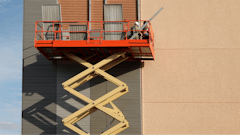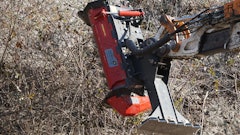
Heading into 2021, landscapers were optimistic. The industry worked hard in 2020 to become labeled “essential” and things started to look promising. Approaching the second half of 2021, it seemed like the economy and daily life would start to fall back into place. But then the variants started showing up—not just of COVID-19, but the Great Resignation and deeper supply chain issues—creating havoc throughout the end of the year.
In a recent reader survey respondents were asked how they felt about the landscape industry overall going into 2022. “Positive on [the] demand for services,” says Andy Sykes, CLP, PCH, owner of Garrett Churchill in Willow Grove, Penn. “Supply chain issues are across the board with every industry, so that has become a common expectation. Labor continues to be a struggle with no end in sight.”
While labor is a continuing years’ long issue that will continue to be prevalent in 2022, lingering pandemic-related supply chain problems will widely affect everything from project materials to equipment availability. With individuals and companies ramping up work-from-home purchases for safety precautions and remote offices, they ate up any pre-pandemic warehouse surpluses and overwhelmed manufacturers as factories closed with no workers, leading to tools-of-the-trade and supplies shortages across many industries. Additionally, green professionals will need to deal with inflation costs in a way that allows them to keep their business going and growing but doesn’t alienate much of their clients in the process.
The good news is the pandemic is causing homeowners and commercial companies to rethink their yards and campuses. Homeowners see their outdoor space as a new sanctuary that gets them out of the house and are willing to use professionals for maintenance and major upgrades. As commercial properties rethink the indoor office space, they’re also turning some attention on the outdoor campus to encourage staff to get away from their desks and safely interact.
To get a sense of what the industry looks like as it mows into 2022, we reached out to experts in the industry to get their perspective of what is happening now.
What is your assessment of the landscaping industry heading into 2022? What are you optimistic about? What will be some of the big challenges?
Britt Wood, CEO, National Association of Landscape Professionals (NALP): Landscape and lawn care companies have weathered and, in most cases, thrived through the immense challenges of the last few years. We are optimistic that the demand for our industry’s services will continue to be strong for both commercial and residential services in 2022. But, pressures from continuing supply chain issues and low unemployment will be challenging in the coming year. However, we continue to work to increase the number of seasonal workers allowed through the H-2B program and have reason to be optimistic that we will have a larger supplemental pool of H-2B visas this year and earlier in the season.
Kris Kiser, CEO and president, Outdoor Power Equipment Institute (OPEI): The industry is moving into 2022 with a real head of steam. Coming off of COVID-19, the industry saw an uptick as homeowners reconnected to the outdoors and recognized their living landscape as a safe space. That certainly translated into investments in their landscapes, hardscapes and pools. We think that reconnection is real, and looking at market sales, we think it’s here to stay. But an increase in business, combined with ongoing supply chain impacts from the pandemic, mean contractors are facing challenges in availability of labor as well as reliable materials availability — including engine product, hardscape supplies and parts.
Harold Redman, SVP, President of Turf & Consumer Products Group, Briggs & Stratton: The overall health of the landscape industry remains encouraging. I’m optimistic that the market for commercial cutting and landscaper services will continue to grow as residential homeowners and commercial businesses continue to see the value of the services provided. I’m also optimistic that some of the challenges we’ve been experiencing for the past two years will start to correct and show improvement for the latter half of 2022 and beyond.
From a market perspective, one factor that drives industry growth is the continued strength of the housing market. More people purchasing and owning homes with yards create great opportunities for landscapers, as a healthy percentage of these homeowners turn to professionals for major landscaping jobs or routine mowing and maintenance.
Joe Raboine, director of residential hardscapes, Belgard: Outdoor living has continued trending upward in 2021, and we expect that to be the case in the new year — ask any contractor, and they are likely booked well into 2022. Homeowners have shifted their thinking about outdoor living in general, prioritizing it to take advantage of health and well-being benefits of spending time outside. People are understanding these spaces are a respite from the craziness of the world, and if our profession can recognize this trend, we will create spaces that are great not just for entertaining, but that foster nurturing and relaxation.
I think the biggest challenges are labor and supply chain issues. The industry has had difficulty attracting qualified workers over the past few years, which may get more difficult in the current job market. The supply chain issues are predicted to continue, but outdoor living professionals can stay ahead of the curve by communicating with clients up front about expectations and product availability.
Brant Kukuk, compact equipment product manager, Ditch Witch: The landscape industry is in a positive place. Demand for new projects has been very strong for many landscapers over the past year and that trend looks to continue into 2022. Manufacturers are seeing orders for machines continually grow, suggesting that landscapers are profitable, busy and looking to expand their operations. As many landscapers deal with the ramifications of the labor shortage, they are increasingly looking for more powerful, versatile machines that can support smaller crew sizes.
Sean McCormick, CEO and Jay Worth, marketing manager, SingleOps: Heading into 2022, the industry is still in a very strong position. Outside investment in the industry continues to climb, and consumers continue to demand our services. We’re optimistic that these trends will continue, and that our industry will continue to strengthen its position in the economy at large.
There are apparent issues — supply-chain snags, labor shortage, etc. The challenges don’t lie in those problems themselves. The main challenges for our industry will be our ability to approach these challenges with a truly creative mindset and thrive in the face of these issues. If we can’t come up with holistic solutions for staffing and supply, we’ll really be in dire straits.
Joe Haynes, president, Little Beaver: The last two years have shown record growth in the landscape market. As more people were stuck at home for extended periods of time, they tried to create their own escape in their home, making it a retreat in the time of lock downs. Contractors and supplies quickly became backlogged so we feel there will be plenty of work to carry over into 2022. Inflation is certainly going to be a challenge, as will getting the equipment and supplies needed to complete these projects. But we believe there is plenty of opportunity for anyone poised to act.
Stephen Chen, CEO, URSrobot: At its core, the landscape industry is a service business. We cater to the needs of people and nature, which is an ongoing need, with technology and knowledge. We are very optimistic about the pivots that create opportunities. Clean energy, robotics and business models are changing to overcome challenges and ultimately strengthen our industry. Education and collaboration will bind our community, leading to new ways to serve and deliver on key landscaping solutions.
How has the pandemic affected the industry in 2021?
Belgard: Being indoors for most of 2020 and into 2021 has shifted the focus of outdoor living from entertaining to functionality — and brought a need for connecting with the outdoors and each other to the forefront. It’s important for industry professionals to understand how expectations and needs have changed so they can be ready to accommodate the customer. Notably, spending on home renovations increased by 15% this year according to Houzz.
NALP: Industry companies rebounded quickly from the initial uncertainty and restrictions of the pandemic. 2020 was a year of uncertainty, especially in the spring as companies figured out how to work through the pandemic. But by 2021, industry companies were in a grove, having adjusted their operations and the demand for landscape and lawn care services was very high. High demand plus pandemic-related supply-chain and workforce shortages created opportunities but also brought challenges for company owners to find a way to meet the demand with more limited resources.
URSrobot: The impact has been felt on supply chains, product shortages, labor shortages and churn. Perhaps some folks have left the industry and less are entering. This blend causes both pain and opportunity. For some the pandemic has resulted in a renewed vision of how to run the business, communicate and manage — fueled by courageous leadership and perseverance — and adoption of new technology.
Briggs & Stratton: There have been labor shortages on the contractor side that have limited the true growth potential of many landscape businesses. The industry was facing a worker shortage prior to the pandemic due to a variety of factors, including challenges getting enough H-2B visas. The pandemic further limited the overall available labor and challenged contractors to find new ways to maintain and grow their businesses. Because of the people shortages, many landscapers also began paying higher wages to their work crews to retain employees and to attract new labor. Those increases are passed onto the customers.
Have the challenges of the pandemic created any business opportunities for landscape contractors? If so, what are those opportunities?
OPEI: Landscapers have really been working with homeowners to tailor their outdoor spaces as a true extension of their home. Those spaces have needed to become classrooms, offices, play spaces, campgrounds — sometimes all at once — as “backyarding” become more and more common. Landscapers have helped homeowners customize those spaces to be purposeful for their customers.
SingleOps: Savvy landscapers did a few things very well and came out ahead over the last two years. One, they positioned themselves to deliver an exceptional experience that was different from the traditional landscape sales process. Companies that embraced digital solutions for estimating and proposing work benefited greatly here.
The second thing smart companies have done was to ramp up their marketing efforts. The tea leaves are indicating that the economy will return to pre-pandemic spending levels for our industry in the near future, and those that took advantage of massive demand to fine-tune their messaging efforts will come out on the other side of the pandemic in an extremely strong position.
NALP: The pandemic initiated a new appreciation of people’s backyards and green spaces. As a result, there continues to be a boon in landscape upgrades, residential lawn care services and large-scale design and installation projects. On the commercial side, properties have added amenities for workers and upgraded landscapes to make facilities attractive for sale. All of which provided opportunities for upselling and add-on services for commercial and residential contractors.
If someone was considering working for the landscape industry, what advice would you give that person?
Briggs & Stratton: Focusing on a few key high-level questions often creates the right template for success. What is the opportunity with the target customers in a location or region? What services could you provide that attract the greatest number of customers, or provide the most attractive profits? What investment is required in equipment, resources, and people? How do you differentiate your business and services from the competition? Do you have a solid financial model for launching your business plan along with the ability to measure your progress and success? What variables within the business can you control or not control that may have a significant impact? Are there incentives to assist you in starting a business?
Belgard: Focus on understanding the needs and lifestyles of your customers. Customers are the priority in this business, and you want to deliver on their expectations — so you can turn them into a repeat customer when they want to build additional projects. Also continue investing in yourself through training programs, courses and conferences so you can stay up-to-date on the latest tools and methodologies.
Ditch Witch: The best first step for any prospective landscaper is to reach out to their local equipment dealer and begin a relationship. Not only do local dealers understand the equipment that a landscaper would need, but they have years of experience working in the region. A local dealer can be a vital resource for questions surrounding jobsite conditions, local regulations and equipment needs.
NALP: The industry has such a wide variety of positions available that it is an excellent fit for people who love nature and the outdoors, have an entrepreneurial spirit, want to solve business or operational challenges, love design or love sales or finance. We continue to promote industry careers through our workforce development programs, our National Collegiate Landscape Competition and Career Fair and our marketing outreach. People who are curious about careers in the industry should visit www.landscapeindustrycareers.org to learn about the various career paths and peruse the job board to find positions available across the country.
What product trends do you expect to continue in 2022?
Ditch Witch: A product trend that will continue in 2022 is the importance of machine versatility. The ability to take on a variety of tasks with one machine will allow landscapers to improve their ROI, reduce costs associated with transporting multiple machines to a jobsite and eliminate needless jobsite clutter. This need for versatility has particularly driven the popularity of stand-on skid steers and their various attachments. While traditional attachments such as forks, trenchers and buckets will remain popular, newer attachments such as tree grapples and backhoes look to grow in use in 2022.
Little Beaver: We expect the high demand for our products to continue in 2022, along with some supply limitations. Landscape contractors should consider ordering ahead of time and work with their manufacturer to understand lead times on the products they need.
OPEI: Landscapers can certainly expect continued evolution in battery/electric equipment. Larger and larger pieces of equipment with more significant runtime are entering the market, mirroring what we saw on the consumer side. We’re seeing more commercial-grade handheld equipment transition, as well as on the wheeled goods side, including commercial walk-behinds and heavier-grade consumer units. Manufacturers are also introducing new product on the engine side, improving fuel efficiency and emissions, including fuel injection increased use of propane.
URSrobot: Without a doubt, autonomous, robotics will continue to be accepted as a business solution. The implementation of this technology requires a wraparound service of education, financial terms and business management. The mandates for clean and green energy will dictate change and likely bring usher in a new era of business operators.





























